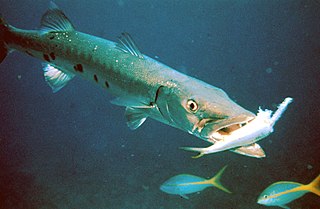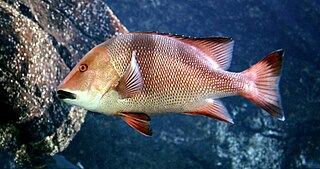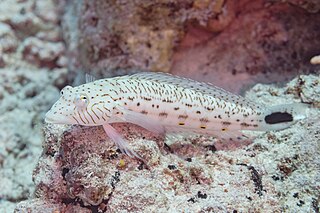
A barracuda is a large, predatory, ray-finned fish known for its fearsome appearance and ferocious behaviour. The barracuda is a saltwater fish of the genus Sphyraena, the only genus in the family Sphyraenidae, which was named by Constantine Samuel Rafinesque in 1815. It is found in tropical and subtropical oceans worldwide ranging from the eastern border of the Atlantic Ocean to the Red Sea, on its western border the Caribbean Sea, and in tropical areas of the Pacific Ocean. Barracudas reside near the top of the water and near coral reefs and sea grasses. Barracudas are targeted by sport-fishing enthusiasts.

Paracanthurus hepatus is a species of Indo-Pacific surgeonfish. A popular fish in marine aquaria, it is the only member of the genus Paracanthurus. A number of common names are attributed to the species, including regal tang, palette surgeonfish, blue tang, royal blue tang, hippo tang, blue hippo tang, flagtail surgeonfish, Pacific regal blue tang, and blue surgeonfish.

The sandperches are a family, Pinguipedidae, of fishes in the percomorph order Trachiniformes. Sandperches are benthic fish which normally occur over sand or rubble substrates in shallow seas. They are found off the coasts of South America, South Africa and in the Indo-Pacific as far east as Japan. The family contains a few species which are used by humans for food.

The tentacled flathead, also known as the Indian Ocean crocodilefish, Madagascar flathead or longhead flathead, is a species of marine ray-finned fish belonging to the family Platycephalidae, the flatheads. This species is in the western Indian Ocean, including the Red Sea and the Mediterranean, having invaded as a Lessepsian migrant through the Suez Canal. It is the only species in the monotypic genus Papilloculiceps.

The longfin yellowtail, also known as the almaco or silvercoat jack, deep-water, falcate, European or highfin amberjack, rock salmon, longfin or yellow kingfish, is a game fish of the family Carangidae; they are in the same family as yellowtail and amberjack. They are carnivorous and feed, both day and night, on other, smaller fish, such as baitfish, small squid, octopus, crab and shrimp. The flesh is thick and dense, like tuna, and easily may be passed off for white albacore if prepared as sushi.

Chrysiptera cyanea is a species of damselfish found in the wide Indo-West Pacific but not known in the Red Sea. A few individuals were observed in the Mediterranean Sea in 2013 off Slovenia, a likely aquarium release.

Lutjanus sebae, also known as red emperor, emperor red snapper, emperor snapper, government bream, king snapper, queenfish or red kelp, is a species of marine ray-finned fish, a snapper belonging to the family Lutjanidae. It is native to the Indian Ocean and the western Pacific Ocean.

The dog snapper, also known as the dogtooth snapper, pargue or snuggletooth snapper, is a species of marine ray-finned fish, a snapper belonging to the family Lutjanidae. It is native to the Atlantic Ocean. It is a commercially important species, and is popular for display in public aquaria.

Plotosus lineatus, common name striped eel catfish, is a species of eeltail catfishes belonging to the family Plotosidae.

Trachurus lathami is a species of fish in the family Carangidae and the genus Trachurus, the jack mackerels. Common names include rough scad and horse mackerel in English, as well as chinchard frappeur (French), chicharro garretón (Spanish), jurel, and carapau, garaçuma, surel, and xixarro. It is native to parts of the western Atlantic Ocean, including seas off the eastern coasts of North and South America and the Gulf of Mexico.

The Borriqueta porgy is a species of marine ray-finned fish, a grunt belonging to the family Haemulidae. It is native to the Atlantic Coast of South America.

Parapercis hexophtalma, the speckled sandperch, is a species of marine bony fish in the family Pinguipedidae, found in the western Indo-Pacific Ocean. It was first described by the French naturalist Georges Cuvier in 1829. There are several synonyms, some of which represent misspellings of the original name, and others which were given to female fish, at the time thought to be a separate species.

Terapon theraps, the largescaled terapon, banded grunter, banded trumpeter, flagtail grunter, flagtail trumpeter, large-scaled grunter-perch, northern grunter and spiky trumpeter, is a species of marine ray-finned fish, a grunter from the family Terapontidae. This species has a wide distribution in the Indo-Pacific region.

Terapon puta, the spiny-checked grunter, three-lined grunter, small-scaled banded grunter, small-scaled terapon, squeaking perch or two-lined grunter, is a species of fish from the Indo-Pacific region, it is a member of the grunter family, Terapontidae. It has also spread into the eastern Mediterranean Sea from the Red Sea through the Suez Canal, a process known as Lessepsian migration.

Jaydia smithi, Smith's cardinalfish, is a species of ray-finned fish from the Indian and Pacific Oceans, a member of the family Apogonidae. It has colonised the eastern Mediterranean Sea by way of the Suez Canal since 2007.

Crenidens crenidens, the karanteen seabream or karanteen, is a species of ray-finned fish from the sea bream family Sparidae which was described by the Swedish zoologist Peter Forsskål in 1775. It is native to the western Indian Ocean but has colonised the eastern Mediterranean Sea since 1970. It is one of only three species in genus Crenidens, the others being the little known Crenidens macracanthus and the partially sympatric C. indicus.

Pseudupeneus prayensis, the West African goatfish, is a species of goatfish, a marine ray-finned fish from the family Mullidae. This fish grows to 55 cm maximal length. The species name "prayensis" refers to the city Praia, the capital of Cape Verde, the species was described with a type locality of "Port Praya, Cape Verde Islands".

Pinguipes is a small genus of sandperches belonging to the fish family Pinguipedidae found in waters off South America.

Pinguipes chilensis, commonly known as the Chilean sandperch, is a species of ray-finned fish in the family Pinguipedidae. It is found in the southeastern Pacific Ocean off the coasts of Peru and Chile.

The Argentine seabass is a species of seabass in the family Serranidae. It occurs on the South American continental shelf of the western Atlantic Ocean, where it used to be caught commercially for human consumption.




















